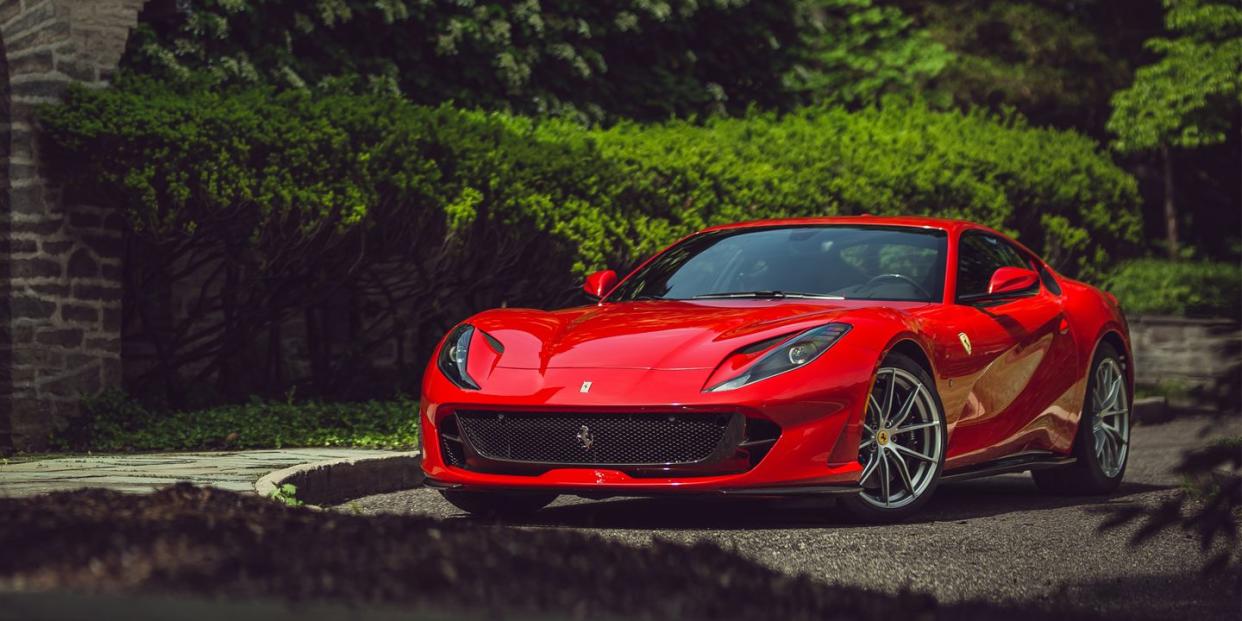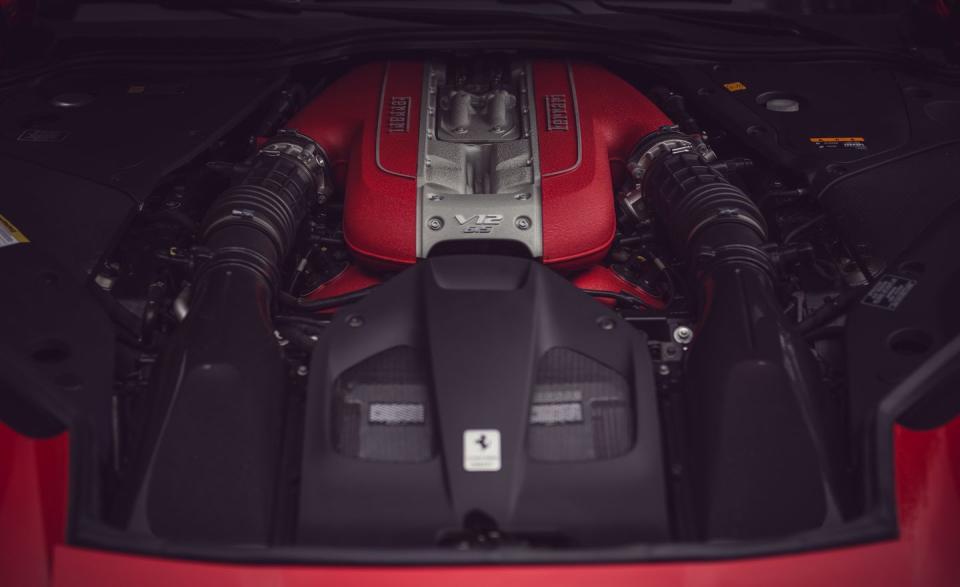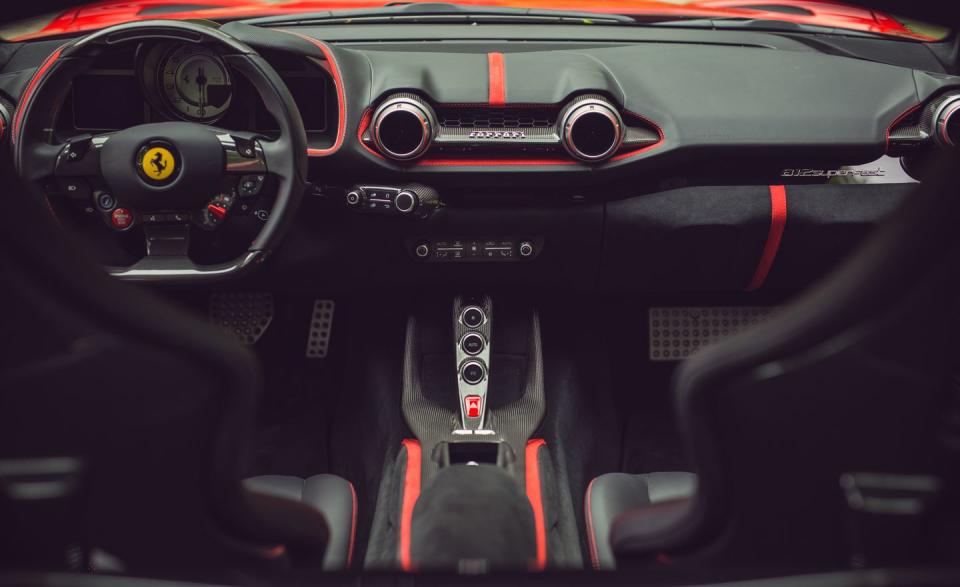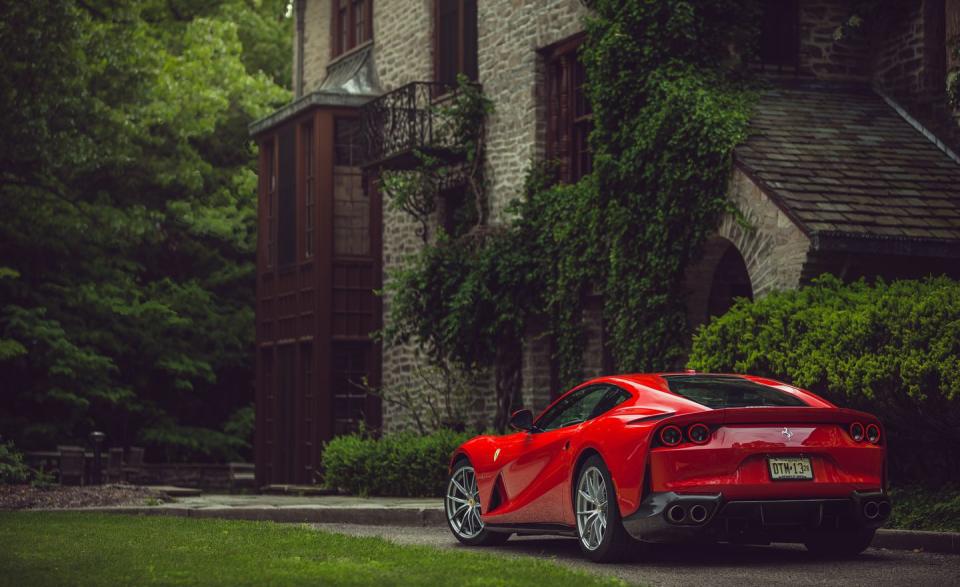Ferrari 812 Superfast, the Literally Named Supercar

At the intersection of circles in the Venn diagram of Ferrari, Car and Driver, and November 1971 lies a very special sliver of commonality. It was then that C/D organized the very first Cannonball Baker Sea-to-Shining-Sea Memorial Trophy Dash. The entrants were a hodgepodge of vehicles, many of them modified. But the winning car, a Ferrari 365GTB/4 Daytona piloted by the one and only Brock Yates and professional racer Dan Gurney, was bone stock. And the spirit of that Ferrari lives on in the 812 Superfast.
What "812" Means
Unlike many other marques, this Ferrari's name is 100 percent literal. The "8" stands for 800 cavalli vapore, Italian for horsepower. Italian horses are a little smaller than the ones bred in Kentucky, so that equates to 789 horsepower in the States. The "12" denotes 12 cylinders, arranged in two banks that are positioned in a perfectly balanced 60-degree V. And "Superfast," well, this car's test numbers speak to that credential.
The engine is one in a long line of V-12s from Ferrari, including the one in that Cannonball pacesetter. In the simplest of terms, this 6.5-liter V-12 is a stroked version of the F12's engine. But, according to Ferrari, it consists of 75 percent new parts, including a system that continuously varies the intake-runner length. Indicated redline is 9000 rpm (although Ferrari says it revs to just 8900). Regardless, given the opportunity, you will explore the upper reaches of engine speed with great frequency. The sound isn't as loud as a 911 GT3's or a McLaren 720's-at wide-open throttle, the 812 emits 91 decibels to the Porsche's 100 and the McLaren's 95-but it's a sound that penetrates the soul. It also reminds you that engineers, when pushed and challenged the way Ferrari's are, can be just as artistic as designers.
How Fast Is Superfast
Rear-wheel-drive cars typically lack the grip required for a sub-3.0-second zero-to-60-mph time, and yet this 812 manages it in 2.8 seconds. It also reaches 100 mph in 5.8 seconds and completes the quarter-mile in 10.5 at a blistering 138 mph. Just 7.1 seconds later, the 812 hits 170 mph. Still, the McLaren 720S (also rear-wheel drive) is quicker, as it weighs nearly 700 pounds less than the 812. That doesn't diminish the fact that the Ferrari is so quick accelerating from 70 mph that it takes not more than a half-mile of open interstate and 9.3 seconds to show the driver and up to one passenger what 150 mph feels like.
Hauling down all that speed are four girthy Pirelli P Zero PZ4 tires and carbon-ceramic brake rotors that wouldn't look undersized on a Boeing 737. Stops from 70 mph require just 142 feet-and this is a car that weighs 3851 pounds.
Cabin ergonomics are excellent. All the normal steering-wheel stalk controls are moved to various buttons on the wheel. The idea is that this allows the driver to keep both hands on the wheel at all times. Shuffle steering isn't necessary, even through roundabouts, since the 812 incorporates rear-axle steering.
Ferrari's longstanding use of magnetorheological dampers-going back to the 2007 599GTB-pays off, as the 812's around-town ride rivals that of a family sedan, particularly in the "bumpy road" mode. Crank the steering-wheel-mounted mode switch to Race, and the 812 will stick with an even 1.00 g of lateral grip.
If the 812 has one dynamic weakness, it's the dual-clutch transaxle. Multiple drivers noted hard shifts, particularly when the gearbox reengages after an auto stop-start engine shutdown when the car comes only to a rolling stop. But that's small-potatoes stuff. Besides, do you really want your Italian exotic to be as smooth in traffic as a Honda Accord?
Even when it's sitting still, the 812 looks as if it's sprinting, particularly with the Rosso Corsa (race red) paint worn by our test example. As you're gazing at it, you can almost see the wind tunnel's labor on its body. Air flows up, over, and around the front fenders through channels and tunnels that appear to have been carved by fluid dynamics. The design does the magic trick of packing in a ton of details without looking too busy. Sure, there is a lot going on, but as with any fine art, the details make the whole picture better. This is, after all, Ferrari's flagship, even listed above the LaFerrari Aperta on its consumer website.
Consumer. What a funny way to think of a Ferrari buyer. This car as it sits costs more than $450,000, about $125K of which is in more than 30 options, including a titanium exhaust and seemingly every carbon-fiber item imaginable. The carbon-fiber racing seats aren't the most comfortable design for a long haul, and if one were to attempt a coast-to-coast run in an 812, that's an option we'd avoid. Still, there is probably no better car in which one could attempt a record-breaking dash from sea to shining sea.
('You Might Also Like',)




